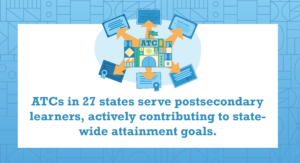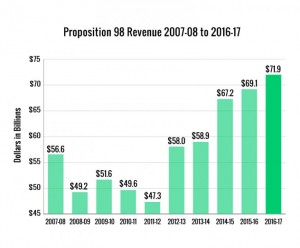 The transformative workforce changes resulting from the COVID-19 (coronavirus) pandemic have made it more urgent than ever for states to have a comprehensive strategy for reskilling and upskilling that unites stakeholders across education, workforce development and economic development. Advance CTE has been vocal that investment in secondary and postsecondary Career Technical Education (CTE) is critical to a national recovery strategy.
The transformative workforce changes resulting from the COVID-19 (coronavirus) pandemic have made it more urgent than ever for states to have a comprehensive strategy for reskilling and upskilling that unites stakeholders across education, workforce development and economic development. Advance CTE has been vocal that investment in secondary and postsecondary Career Technical Education (CTE) is critical to a national recovery strategy.
ATC Positioning in the Workforce Development System
The COVID-19 pandemic has disrupted many things in our way of life, including the education or training path most Americans will pursue to return to work. A typical economic recovery would have millions of Americans flocking to traditional higher education programs but instead, in this post-pandemic economic recovery, the majority of Americans say they will seek non-degree and skill-based education and training programs to reskill or upskill their way back to a good job.
Area technical centers (ATCs) should be part of this solution – helping more Americans secure non-degree credentials of value. Our national analysis found that in the states where ATCs serve an adult population, these institutions provide short-term credentials and programs below the level of an associate’s degree, and are uniquely positioned to be nimble and responsive to changing workforce needs. Further, these institutions are accessible, by design serving a region, and low-cost, with few or no barriers to admission for adult learners and affordable tuition rates as low as $2.00 per seat hour. ATCs can and should be better leveraged to serve those who have been disproportionately impacted by job losses associated with the pandemic, particularly Black and Latinx workers, workers with a high school education or less, and female workers.
Leveraging Federal Funding
Funding matters, and in states that have leveraged federal funds, we see ATCs being key players in meeting the state’s short- and long-term workforce priorities.
For example, all of Ohio’s Ohio technical colleges (OTCs) and selected programs in Delaware’s ATCs are eligible training providers under the Workforce Innovation and Opportunity Act. Many ATCs are eligible for federal financial aid under Title IV of the Higher Education Act, including institutions in Florida, Ohio and Utah most commonly accredited by the Council on Occupational Education.
Some states have utilized 2020 federal stimulus funding to reinforce their ATCs as valuable institutions in an economic recovery. Delaware leveraged $10 million of its federal Coronavirus Aid, Relief, and Economic Security (CARES) Act economic relief funding to support its Forward Delaware initiative, a set of rapid training and credentialing programs focused on in-demand occupations and skills in the state. Florida’s governor designated Governor’s Emergency Education Relief Fund (GEER) funds provided through the CARES Act to award grants to its ATCs, known as technical colleges, to establish or enhance rapid credentialing programs that lead to a short-term certificate or industry-recognized certification as part of its statewide Get There campaign.
Utilizing ATCs in Statewide Workforce Training Programs
ATCs have strong connections to their local communities and employers by design and often offer customized training programs to meet those needs.
- Oklahoma’s State Training for Industry Growth (TIG) program provides funding to their ATCs, known as technology centers, to administer short term employee training programs for businesses experiencing skill shortages. The state CTE agency also offers a Training for Industry Program (TIP) that utilizes technology centers as business incubators and employee training providers for designated high-demand industries; over 4,000 employees were trained in FY20.
- Utah’s Custom Fit program allows employers to utilize technical colleges to provide employee training at no cost to the employee. Each technical college employs a program director which is partially supported through state funding, and at least 50 percent of the training costs are paid by the employer. Over 19,000 employees participated in this program in FY19.
- Ohio provides not only an employee training program, but an opportunity for its Ohio technical centers (OTCs) to participate in more strategic workforce initiatives. An OTC can be designated a Center for Training Excellence, making them eligible for up to $500,000 in state funding that is matched by the OTC to offer custom training and consulting to local employers. Ohio’s Regionally Aligned Priorities in Delivering Skills (RAPIDS) program looks at the bigger picture by providing $8 million in equipment investments to postsecondary institutions to retain, attract, and strengthen industry and support workforce development initiatives. OTCs are able to participate by partnering with a community college.
To recover from the devastation of the coronavirus will require persistence, creativity and leveraging all public assets to ensure a full and equitable economic recovery. States should be learning from one another – what worked and what didn’t – and leveraging their public assets, including ATCs to every learner with the opportunity to access a career pathway that leads to sustained, living-wage employment in an in-demand field.
To find the ATCs in your state and to access the full report and additional resources, please visit www.areatechnicalcenters.org . To read other posts in this series, please check out our Medium post that breaks down the major findings, and our blog post on leveraging ATCs to advance state postsecondary attainment goals.


 Advance CTE’s recent report on area technical centers (ATCs),
Advance CTE’s recent report on area technical centers (ATCs),  Some states are exploring how to leverage apprenticeships to award college credit to learners. For instance, the Colorado legislature passed
Some states are exploring how to leverage apprenticeships to award college credit to learners. For instance, the Colorado legislature passed  Meanwhile, the Ohio Department of Education expanded options for students on the credential graduation pathway by
Meanwhile, the Ohio Department of Education expanded options for students on the credential graduation pathway by  With students now on summer vacation, policymakers have been hard at work preparing for the upcoming school year – and Career Technical Education (CTE) has been front and center in several states. Last month, California approved a massive budget, including funds for the CTE Pathways Program and the new Strong Workforce Program. Meanwhile, some states are exploring strategies to address teacher shortages.
With students now on summer vacation, policymakers have been hard at work preparing for the upcoming school year – and Career Technical Education (CTE) has been front and center in several states. Last month, California approved a massive budget, including funds for the CTE Pathways Program and the new Strong Workforce Program. Meanwhile, some states are exploring strategies to address teacher shortages.